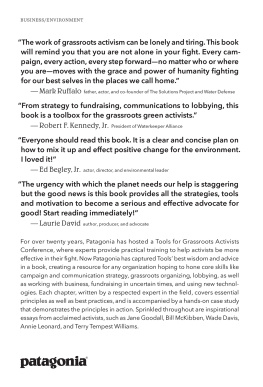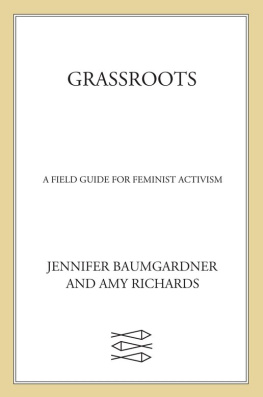
About the author
Aidan Ricketts is an experienced social and environmental activist as well as a prominent activism educator, academic and writer. Aidan has written for many academic journals and contributed to several books. He is also a lecturer with the School of Law and Justice at Southern Cross University, Lismore, Australia.

The Activists Handbook: A step-by-step guide to participatory democracy was first published in 2012 by Zed Books Ltd, 7 Cynthia Street, London N 1 9 JF , UK and Room 400, 175 Fifth Avenue, New York, NY 10010, USA
www.zedbooks.co.uk
Copyright Aidan Ricketts 2012
The right of Aidan Ricketts to be identified as the author of this work has been asserted by him in accordance with the Copyright, Designs and Patents Act, 1988
The illustrations were drawn by Kudra Falla
Set in FF Kievit and Monotype Plantin by Ewan Smith, London
Index: ed.emery@thefreeuniversity.net
Cover designed by Rogue Four Design
All rights reserved. No part of this publication may be reproduced, stored in a retrieval system or transmitted in any form or by any means, electronic, mechanical, photocopying or otherwise, without the prior permission of Zed Books Ltd.
A catalogue record for this book is available from the British Library
Library of Congress Cataloging in Publication Data available
ISBN: 9781780324135
FIGURES
Introduction: cycles within cycles
Recently I provided a community activism consultancy for a group of residents threatened by the rising sea-level on Australias east coast. It was different from my usual line of work; these were not environmentalists fighting some new damaging development, or local residents busting political corruption. This was a group of property owners, threatened by erosion and frustrated at the governments lack of compassion for their communitys predicament. Most of these people had never been activists before; they had previously enjoyed a quiet life by the sea until the tide of history (and the tide itself) shocked them out of the complacent belief that the government could be relied upon to take care of their interests. Some of my activist colleagues queried why I was helping this group of people, whose concerns seemed largely proprietary and only partly communitarian in nature. While I was helping map their campaign, one of the residents also asked me, What is your interest in coming here and helping us? Why are you doing this? It was as if he suspected I had another another motive. After explaining that I was actually receiving a small fee, I went on to explain the real reason why I was there.
I believe in real democracy, and I believe in the power of communities to organize to pursue their interests, and I am passionate about helping people take a stand and make a difference in the world.
To many of my activist colleagues, and even to many of the residents themselves, the issue looked like just another NIMBY (not in my backyard) issue, but to me it was so much more. This little community was faced with the loss of their homes owing to climate change; they were a test case for how society and government would respond to the impact of climate change, and more importantly they provided a human face to an issue which to many people had so far only been an abstract environmental problem.
I sincerely believe that when people wake one day to find an issue on their doorstep that they cannot just ignore, there is enormous potential for transformation. This is why I am supportive of many groups that others may label as NIMBY. What is important in all community campaigns is the potential to overcome passivity and unleash empowerment. My social change work has shown me time and again that when individuals first break the habit of political passivity they begin a journey from being a passive subject to an active citizen and beyond to being a lifelong activist. Taking a stand on a local issue, or even taking a small stand on a big global issue, may seem like a small step, but for so many people it unleashes a power that lies dormant in us all. In this book I discuss the life cycle of social movements, but underlying this is the life cycle of activists themselves.
When a person first takes a stand on an issue, they are transformed. The people around them start to see them differently; their neighbours and colleagues may see them as a potential leader, their opponents as a threat. Soon enough their first ordeal of awakening occurs, most often when they are attacked publicly for having dared to stand up. Possibly for the first time in their lives they encounter first-hand the stubbornness, lies, hypocrisy and embedded corruption that reinforce the vested interests they have dared to oppose or question. This is a critical stage for people; they may become despondent and defeated. But more often there is a great dissonance that ignites a fire in the belly far deeper and more powerful than the small issue that first awakened them; they begin to feel the need to make changes in the world around them, to change the values, attitudes and world views that caused the problems in the first place. From a NIMBY a much grander social change activist is frequently born.
There is also a tertiary stage in the life cycle of an activist, something like the metamorphosis of a larva to an adult insect, capable of multiplying its own kind many times over. This metaphor begins to explain why I have written this book.
After working long and hard on a campaign, and particularly after achieving success, we may ask: What next? Should I simply retire from the field and take all my experience and knowledge with me? Or should I choose another campaign and throw myself into it with the same passion and energy? Or is there a more effective path?
For me, the answer was obvious; as an educator, educational designer and experienced activist, the best contribution I could make for the future was to become an activism educator. I realized that as an activist I could really only work on one campaign at a time, but if I could help train up other activists then hundreds, possibly thousands, of campaigns might benefit. This in itself caused me to realize that my own world view had expanded remarkably, and instead of being issue-focused I had become focused upon the process of social change and participatory democracy itself.
Since then my passion has been to develop resources that can guide other activists and social change advocates to greater insight and success. This book is not about the issues that people work on, it is about how to go about it. I am comfortable with the idea that some people may use this book to work on campaigns that I may not agree with. To me its not about the issue, its about empowering people to take a stand.
The ideas for this book began many years ago as a manual for activist training that accompanied face-to-face training camps for the North East Forest Alliance (NEFA). Later the opportunity arose to develop a university-accredited Public Interest Advocacy course through Southern Cross University. The university course has been an ongoing success, but there was a need to reach out to the wider community, and so together with some colleagues I started running activism clinics at a major public festival at Woodford in Queensland from 2003. It was through these clinics that many opportunities for real-life consultancies arose and I was able to refine, field-test and further develop the techniques and tools contained in this book. But once again there was a limit to my ability to visit groups in person and conduct workshops to tune up their campaigns, so I decided to develop a set of written materials.
Next page









